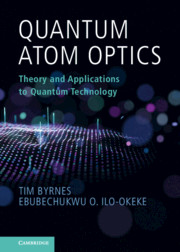Book contents
- Frontmatter
- Dedication
- Contents
- Foreword
- Preface
- 1 Quantum Many-Body Systems
- 2 Bose–Einstein Condensation
- 3 The Order Parameter and Gross–Pitaevskii Equation
- 4 Spin Dynamics of Atoms
- 5 Spinor Bose–Einstein Condensates
- 6 Diffraction of Atoms Using Standing Wave Light
- 7 Atom Interferometry
- 8 Atom Interferometry Beyond the Standard Quantum Limit
- 9 Quantum Simulation
- 10 Entanglement Between Atom Ensembles
- 11 Quantum Information Processing with Atomic Ensembles
- References
- Index
7 - Atom Interferometry
Published online by Cambridge University Press: 23 July 2021
- Frontmatter
- Dedication
- Contents
- Foreword
- Preface
- 1 Quantum Many-Body Systems
- 2 Bose–Einstein Condensation
- 3 The Order Parameter and Gross–Pitaevskii Equation
- 4 Spin Dynamics of Atoms
- 5 Spinor Bose–Einstein Condensates
- 6 Diffraction of Atoms Using Standing Wave Light
- 7 Atom Interferometry
- 8 Atom Interferometry Beyond the Standard Quantum Limit
- 9 Quantum Simulation
- 10 Entanglement Between Atom Ensembles
- 11 Quantum Information Processing with Atomic Ensembles
- References
- Index
Summary
This chapter describes the Bose--Einstein condensate (BEC) interferometry. We first introduce the optical interferometer, briefly discussing the role of fringe contrast in observing interference patterns. Next, we examine a BEC interferometer in a Michelson geometry that consists of a BEC in a trapping potential well. The BEC cloud in the potential well is put into a linear superposition of two clouds that travel along different paths in the trap and are recombined using the same light beams. By studying the population of atoms in the different motional states of the BEC clouds that emergeafter recombination, we obtain information about the relative phase shift accumulated by the two traveling superposed condensates during the interferometry. We then characterize the atom distribution that is found in the output of the interferometer by finding the probability density distribution and calculating the features of the probability density such as the mean, the variance, and the interference fringe contrast. Finally, we parameterize the effect of two-body collisional interactions on the observed interference fringes in a way that can be directly controlled in an experiment.
Keywords
- Type
- Chapter
- Information
- Quantum Atom OpticsTheory and Applications to Quantum Technology, pp. 115 - 129Publisher: Cambridge University PressPrint publication year: 2021

